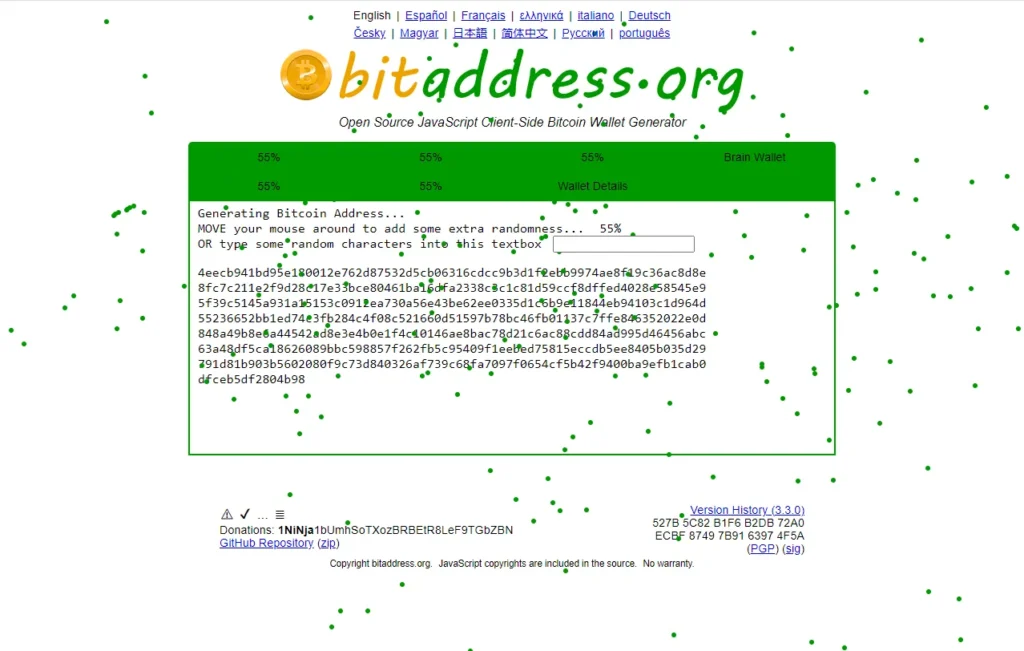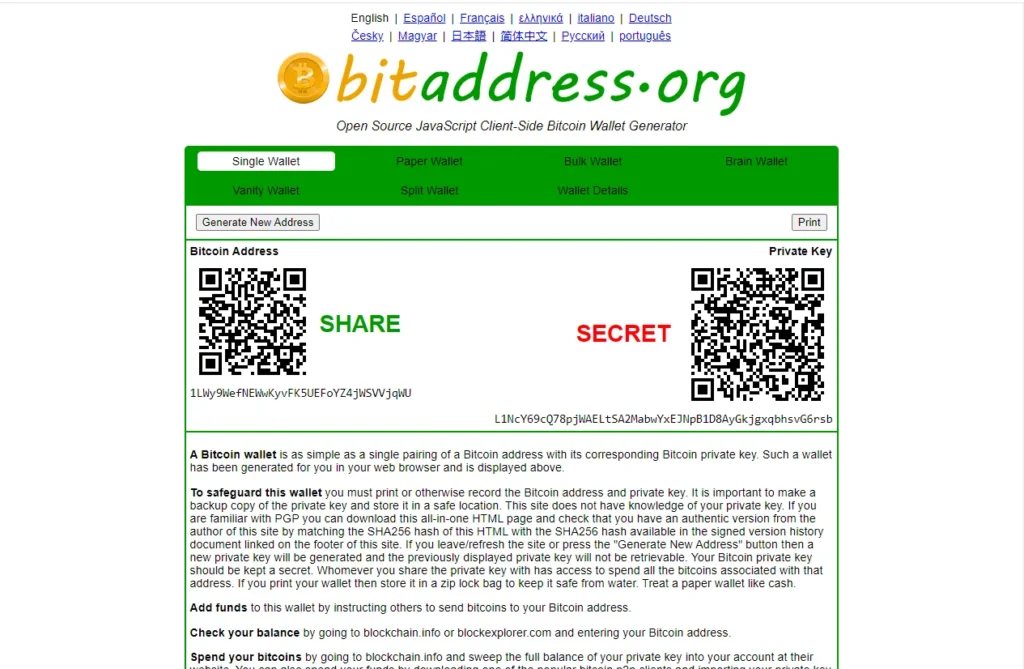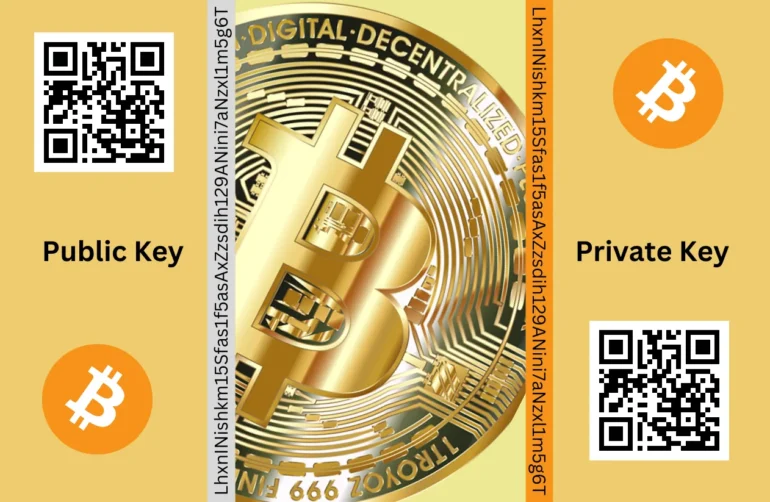Welcome to the world of paper wallets, where your Bitcoins or any coins can take a break from their digital adventures and cozy up in good old-fashioned cash. With a Bitcoin address generated by bitaddress, you can securely store your cryptocurrencies in physical form. Picture this: your private keys, safely tucked away in a software wallet offline, outsmarting online threats like a Bitcoin wallet ninja hiding in plain sight
Paper wallets have become the go-to choice for those seeking an extra layer of security for their Bitcoins and digital assets. By storing your bitcoins in a Bitcoin address printed on paper, you can keep them safe from online threats. It’s like storing your digital wealth on a flash drive but with the added benefit of being offline.
Whether you’re using Windows, Mac, or Ubuntu, paper wallets are a reliable way to protect your Bitcoins. Think of the p2p client wallet as the secret hideout for your precious Bitcoin or any crypto, away from prying eyes and nimble-fingered hackers. It’s like having a secure vault on your stored on a flash drive. Creating a Bitcoin paper wallet app involves generating and printing out a unique set of public and private keys – it’s like giving birth to your own little cryptocurrency guardian.
But wait! Before you start searching for that dusty printer buried deep in the attic, let’s dive into the nitty-gritty details of paper wallets for Bitcoin. This will help you understand the app and process involved.
So buckle up and get ready to unlock the secrets of crypto paper wallets! This process will guide you through the steps.
Understanding the Role of Paper Wallets in Cryptocurrency
Cryptocurrency has revolutionized the way we think about money and transactions. With digital assets like Bitcoin becoming increasingly popular, it’s essential to understand how to keep them safe from online threats. That’s where paper wallets come into play. These physical representations of cryptocurrency holdings offer a secure offline storage solution, reducing the risk of hacks or theft.
The Basics of Paper Wallets
When we talk about crypto paper wallets in the context of cryptocurrencies, we’re referring to a printed document that contains both public and private keys. Public keys are used for receiving crypto funds/crypto coins or whatever you call it, while private keys are required to access and transfer those funds. By storing these Bitcoin keys on a piece of paper instead of an online platform, users can protect their digital assets from cybercriminals.
Security Benefits of Paper Wallets
One key advantage of using paper wallets for Bitcoin is enhanced security. Unlike online wallets or exchanges that can be vulnerable to hacking attempts, paper wallets keep your crypto offline. This means that even if your computer gets infected with malware or your online accounts get compromised, your digital assets stored in a paper wallet remain safe.
Moreover, when you generate a paper wallet offline, there is no chance for hackers to intercept your private keys during the creation process. This adds an extra layer of protection against potential attacks.
Long-Term Storage and Backup Option
Paper wallets are not only suitable for long-term storage but also serve as backup options for other forms of digital wallets. If you have significant amounts of cryptocurrency that you don’t plan on using regularly, storing them in a paper wallet provides peace of mind knowing they are securely tucked away.
Having a backup option is crucial in case you lose access to your primary digital wallet due to technical issues or forgotten passwords. By keeping a printed copy of your private keys in a secure location like a safe deposit box or hidden at home, you’ll always have an alternative method to regain control of your digital assets.
The Purpose of Private Keys
At the core, paper wallets are designed to ensure the safekeeping and accessibility of private keys. Private keys are essentially secret codes that give you ownership and control over your cryptocurrency. They allow you to sign transactions and prove that you are the rightful owner of the funds associated with your public key.
By storing private keys on a physical medium like paper, users can have complete control over their digital assets without relying on third-party services. This decentralized approach aligns with the fundamental principles of cryptocurrencies, where individuals have full sovereignty over their money.
How Paper Wallets Work and Their Security Features
What is a paper wallet?
A paper wallet is a physical representation of a cryptocurrency wallet. It consists of two QR codes, one representing the public key and the other representing the private key. Alongside these QR codes are alphanumeric strings that correspond to the keys. These keys are essential for accessing and managing funds stored in the wallet.
Accessing funds from a paper wallet
To access funds stored in a paper wallet, users need to import the private key into a compatible software or hardware wallet. This process involves scanning or manually entering the private key into the designated software or hardware device. Once imported, users can view their balance, make transactions, and manage their cryptocurrencies securely.
It’s important to note that after importing the private key into a digital wallet, it’s recommended to transfer all funds from the paper wallet to another secure storage method. This reduces the risk of potential security vulnerabilities associated with reusing an exposed private key.
Security features of paper wallets
Paper wallets offer several security features that make them an attractive option for storing cryptocurrencies:
- Encryption: The alphanumeric strings on a paper wallet are often encrypted to enhance security further. Encryption adds an extra layer of protection against unauthorized access by ensuring that only those with knowledge of the decryption method can read and use the keys.
- Tamper-evident designs: Many paper wallets incorporate tamper-evident designs as an added security measure. These designs make it evident if someone has tampered with or attempted to open the physical representation of the wallet. Tamper-evident seals or holographic stickers are commonly used for this purpose.
- Offline generation methods: Paper wallets are typically generated offline, minimizing exposure to potential online threats such as malware or hacking attempts during creation. Offline generation ensures that sensitive information remains secure throughout the process.
Keeping paper wallets physically secure
While paper wallets offer robust security features, it’s crucial to keep them physically secure to prevent unauthorized access. Here are some measures to consider:
- Safe storage: Store paper wallets in a safe or secure location where they are protected from physical damage and theft. Consider using fireproof and waterproof containers for added protection.
- Multiple copies: Create multiple copies of the paper wallet and store them in separate secure locations. This provides redundancy in case one copy is lost or damaged.
- Avoid digital storage: To maintain the highest level of security, refrain from digitizing or storing images of your paper wallet on electronic devices. Digital files can be vulnerable to hacking and malware attacks.
- Be discreet: Avoid displaying or discussing your paper wallet publicly to minimize the risk of attracting unwanted attention or potential theft.
By following these physical security practices, users can ensure that their paper wallets remain safe from unauthorized access, providing peace of mind when storing cryptocurrencies offline.
Step-by-Step Guide: Creating a Secure Paper Wallet for Cryptocurrencies
Generate a new pair of public and private keys using a trusted offline tool or website.
To create a secure paper wallet for your cryptocurrencies, the first step is to generate a new pair of public and private keys. It is crucial to use a trusted offline tool or website to ensure the highest level of security. One popular offline tool that you can use is BitAddress, which allows you to generate Bitcoin paper wallets.
Visit BitAddress
To begin, visit the website BitAddress using your computer. Make sure you are running it on an operating system like Ubuntu, known for its robust security features. Once you in the website, it is recommended that you turn off your internet since the BitAddress website can work when offline.
Generate A Paper Wallet

Once you are on the website, you can start generating your paper wallet. To generate just look at the percentage bar on the website, as you move your mouse, the percentage increases, just keep your mouse moving until it reaches 100%.
The software will use cryptographic algorithms to generate random strings of characters that will serve as your keys. It is important to note that these keys are unique and should be kept confidential.
When it’s 100% it means the generation process is complete then it will show you the complete paper wallet with a Bitcoin address, It includes a QR code and public and private keys.

Print out the QR codes and alphanumeric strings representing the keys on an offline printer or write them down manually.
After generating your public and private keys, it’s time to transfer them onto physical paper for safekeeping. You have two options: either print out the QR codes and alphanumeric strings representing the keys using an offline printer or write them down manually by hand.
If you choose to print them out, make sure you do so using an offline printer connected directly to your computer. This ensures that there is no chance of any malware intercepting or tampering with your data during the printing process.
On the other hand, if you prefer writing them down manually, use pen and paper instead of typing them into any digital device. This eliminates any risk associated with keyloggers or other malicious software capturing your keystrokes.
Whichever method you choose, double-check that everything is accurate before proceeding to the next step.
Ensure that no one else has access to your private key during this process.
The security of your paper wallet heavily relies on keeping your private key confidential. It is crucial to ensure that no one else has access to it during the entire process of creating and storing your paper wallet.
To prevent any potential breaches, make sure you are in a secure location where no prying eyes or unauthorized individuals can see what you are doing. If necessary, consider working in a private room or using privacy screens to shield your actions from view.
Be cautious when handling digital files containing your keys. Avoid storing them on a web server or any online platform that may expose them to potential hackers. Instead, keep them securely stored offline on an encrypted USB drive or external hard disk.
Remember, the strength of your paper wallet lies in its exclusivity. By ensuring that only you have access to the private key, you significantly reduce the risk of unauthorized access and potential loss of funds.
Store multiple copies in secure locations while safeguarding against damage or loss.
Once you have generated and printed/written down your paper wallet’s public and private keys, it is essential to store multiple copies in secure locations. This redundancy ensures that even if one copy gets damaged or lost, you still have access to your funds through another copy.
Consider storing copies of your paper wallet in different physical locations.
Key Considerations for Safeguarding Your Paper Wallet
Protecting Your Paper Wallet from Physical Damage
One of the most important considerations is protecting it from physical damage. Your paper wallet contains crucial information like your Bitcoin address and private key, which are vital for accessing your funds. To ensure the longevity of your paper wallet, you must keep it away from moisture, fire, direct sunlight, or any potential physical damage that could render it unreadable.
Imagine if your paper wallet gets soaked in water or accidentally catches fire. All that important information would be lost forever, and you would have no way to access your funds. That’s why it’s crucial to store your paper wallet in a secure location where it won’t be exposed to these risks. Consider using a waterproof and fireproof container or even a safe deposit box at a bank.
In addition to protecting against environmental factors, you should also take steps to prevent theft or loss of your paper wallet. Make sure you have multiple copies stored in separate secure locations. This way, if one copy gets damaged or goes missing, you’ll still have other backups available. It’s always better to be safe than sorry.
Increasing the Durability of Your Paper Wallet
To further enhance the durability of your paper wallet crypto, consider using protective measures such as laminating it. Laminating can help shield the paper from wear and tear caused by frequent handling or accidental spills. By encapsulating your paper wallet in plastic layers, you add an extra line of defense against physical damage.
Laminating is not the only option available; there are other protective measures you can explore too. Some people choose to use special sleeves designed specifically for storing and protecting paper wallets. These sleeves often come with additional features like tamper-evident seals or built-in anti-static properties to prevent damage caused by static electricity.
Whatever protective measure you choose, make sure it doesn’t compromise the readability of your paper wallet. The information on your paper wallet, including the Bitcoin address and private key, must remain clear and legible. So, consider testing different methods before settling on one that provides both durability and readability.
Regularly Checking and Updating Your Paper Wallet Backups
No matter how well you protect your paper wallet crypto, there’s always a chance that something could go wrong. Hackers are constantly looking for vulnerabilities to exploit, whether it’s through malware-infected websites or compromised servers. Therefore, it’s essential to regularly check the condition of your paper wallet and create new backups if necessary.
Regularly inspecting your paper wallet allows you to identify any signs of wear or damage early on. If you notice any fading ink or smudges that could affect the readability of important addresses and keys, it’s time to create a new backup immediately. Remember, prevention is better than cure.
When updating your backups, ensure they are stored in separate secure locations as mentioned earlier. This redundancy ensures that even if one backup is compromised or lost, you’ll still have other copies available for recovery. Consider making digital copies of your paper wallet using a scanner or taking high-resolution photographs as an extra precautionary measure.
Remember that securing your crypto assets is not a task to be taken lightly.
Exploring Advanced Methods: Other Analog Cold Storage Options
Enhanced Durability and Resistance
In addition to paper wallets, there are other analog cold storage options available for securely storing your cryptocurrencies. These alternatives, such as metal wallets, engraved plates, or even etching keys onto physical objects, offer enhanced durability and resistance against physical damage compared to traditional paper wallets.
Metal wallets are made from materials like stainless steel or titanium, providing a robust and long-lasting solution for storing your crypto assets. These wallets often come in the form of small plates or cards that can be easily carried in a wallet or stored in a safe place. The metal construction ensures protection against wear and tear, making it suitable for long-term storage.
Engraved plates offer another option for analog cold storage. These plates are typically made from materials like brass or aluminum and feature the engraved private key information necessary to access your funds. The engraving process creates a permanent mark on the plate, ensuring that the information remains intact even under adverse conditions.
For those looking for a unique approach to analog cold storage, etching keys onto physical objects can be an interesting choice. This method involves engraving or etching the private key onto items such as coins, jewelry, or other personal belongings. By doing so, you create a physical item with inherent value while also securing your cryptocurrency assets.
Extra Protection Against Damage
Analog cold storage options provide an extra layer of protection against potential loss due to fire or water damage. Unlike digital devices like flash drives or hard drives that can be susceptible to electronic failures or data corruption caused by environmental factors, analog solutions are not reliant on any specific operating system or software.
With analog methods, you don’t have to worry about compatibility issues with different devices or operating systems. You can simply store your private keys in a tangible form without relying on any particular technology. This simplicity ensures that you can access your funds at any time without the need for a computer or any other electronic device.
Furthermore, analog cold storage options offer peace of mind in case of natural disasters. In the event of a fire or flood, paper wallets may be destroyed, potentially resulting in the loss of your cryptocurrency. However, metal wallets, engraved plates, or etched physical objects are more likely to withstand such incidents and protect your private keys from damage.
Customizable Materials and Designs
One advantage of analog cold storage solutions is the ability to choose from various materials and designs that suit your preferences. Metal wallets come in different finishes and sizes, allowing you to select one that matches your style while still providing top-notch security for your crypto assets.
Engraved plates can be customized with unique patterns or designs that make them visually appealing while maintaining their functionality as secure storage devices. You can even opt for personalized engravings to add a touch of individuality to your analog cold storage solution.
Etching keys onto physical objects opens up endless possibilities for customization. Whether it’s a commemorative coin, a piece of jewelry like a pendant or ring, or even an everyday item like a keychain, you have the freedom to choose an object that holds personal significance. This way, you not only keep your cryptocurrencies safe but also possess something tangible that reflects your personality and style.
Risks and Best Practices in Paper Wallet Creation and Storage
The main risk associated with paper wallets is the potential loss or destruction of the physical copy containing private keys.
Losing or damaging a paper wallet can have severe consequences, as it essentially means losing access to your cryptocurrency holdings. Unlike digital wallets, which can be easily recovered with backup phrases or passwords, paper wallets rely solely on the physical piece of paper they are printed on. If this paper is lost, stolen, or destroyed, there is no way to retrieve the private keys and regain control over your funds.
To mitigate this risk, it is crucial to take several precautions. First and foremost, make multiple copies of your paper wallet and store them in secure locations. This could include a safe deposit box at a bank or a fireproof safe in your home. By keeping backups in different places, you ensure that even if one copy gets lost or damaged, you still have access to your private keys through another copy.
Regularly update your backups as needed. If you generate a new address or make significant changes to your crypto holdings, it’s essential to create fresh copies of your paper wallet. This ensures that your backup reflects the most up-to-date state of your cryptocurrency portfolio.
Avoid generating paper wallets on compromised devices or websites that may compromise the security of your private keys.
Creating a paper wallet requires generating a pair of cryptographic keys: a public key for receiving funds and a private key for accessing those funds. It is crucial to generate these keys securely to prevent any unauthorized access to your cryptocurrencies.
One common mistake people make is using compromised devices or websites when creating their paper wallets. Malicious software on such devices can capture sensitive information like private keys during the generation process without you even realizing it. Similarly, untrustworthy websites may collect the data you enter while creating a paper wallet and use it maliciously later on.
To avoid these risks, always ensure that you are using a trusted, secure device when generating your paper wallet. Ideally, use a dedicated computer or hardware wallet specifically designed for this purpose. Only utilize reputable websites or software that have been thoroughly vetted by the crypto community.
Always double-check addresses when transferring funds from a paper wallet to ensure accuracy.
Transferring funds from a paper wallet involves manually entering the recipient’s address into a digital wallet or exchange platform. This step is critical but can also be prone to human error.
To minimize the risk of sending funds to the wrong address and potentially losing them forever, it is essential to double-check the entered address before confirming any transactions. Compare each character carefully and verify its accuracy. Cryptocurrency addresses are typically long strings of alphanumeric characters, so even a small mistake can lead to irreversible consequences.
One way to mitigate this risk is by using copy-paste functionality whenever possible. By copying and pasting the recipient’s address instead of typing it manually, you eliminate the possibility of making mistakes due to typos or misread characters.
Summary of Paper Wallet Crypto and Final Thoughts
We delved into understanding the role of paper wallets in cryptocurrency and how they work with their security features. We provided a step-by-step guide on creating a secure paper wallet for cryptocurrencies, along with key considerations for safeguarding it.
Now that you have a solid grasp on paper wallet crypto, it’s time to take action and secure your digital wealth. Remember to store your paper wallet in a safe place, away from prying eyes and potential risks. Regularly back up your private keys and consider using additional layers of security such as encryption or splitting your keys into multiple parts.
Protecting your cryptocurrency is crucial in this ever-evolving digital landscape. By implementing the best practices discussed in this blog post, you can ensure the safety of your funds while enjoying the benefits of decentralization and financial freedom that cryptocurrencies offer.
FAQs
Can I create multiple paper wallets for different cryptocurrencies?
Yes, you can create separate paper wallets for different cryptocurrencies. Each wallet will have its own unique public and private keys associated with it.
How often should I update my paper wallet backup?
It is recommended to update your paper wallet backup whenever there are significant changes to your cryptocurrency holdings or if you generate new addresses. Regularly backing up ensures that you have access to the latest information needed to recover your funds if necessary.
Are there any alternatives to paper wallets for offline storage?
Yes, apart from paper wallets, there are other analog cold storage options available such as metal wallets or engraved plates. These options provide an additional layer of durability compared to traditional paper wallets.
Can I reuse a paper wallet once I’ve spent all the cryptocurrency stored in it?
While technically possible, reusing a paper wallet is not recommended due to security reasons. It is best practice to generate a new paper wallet each time you want to store additional funds.
What happens if my paper wallet gets damaged or destroyed?
If your paper wallet gets damaged or destroyed, it is essential to have a backup copy of your private keys stored in a secure location. This backup will allow you to recover your funds even if the physical paper wallet is no longer usable.


